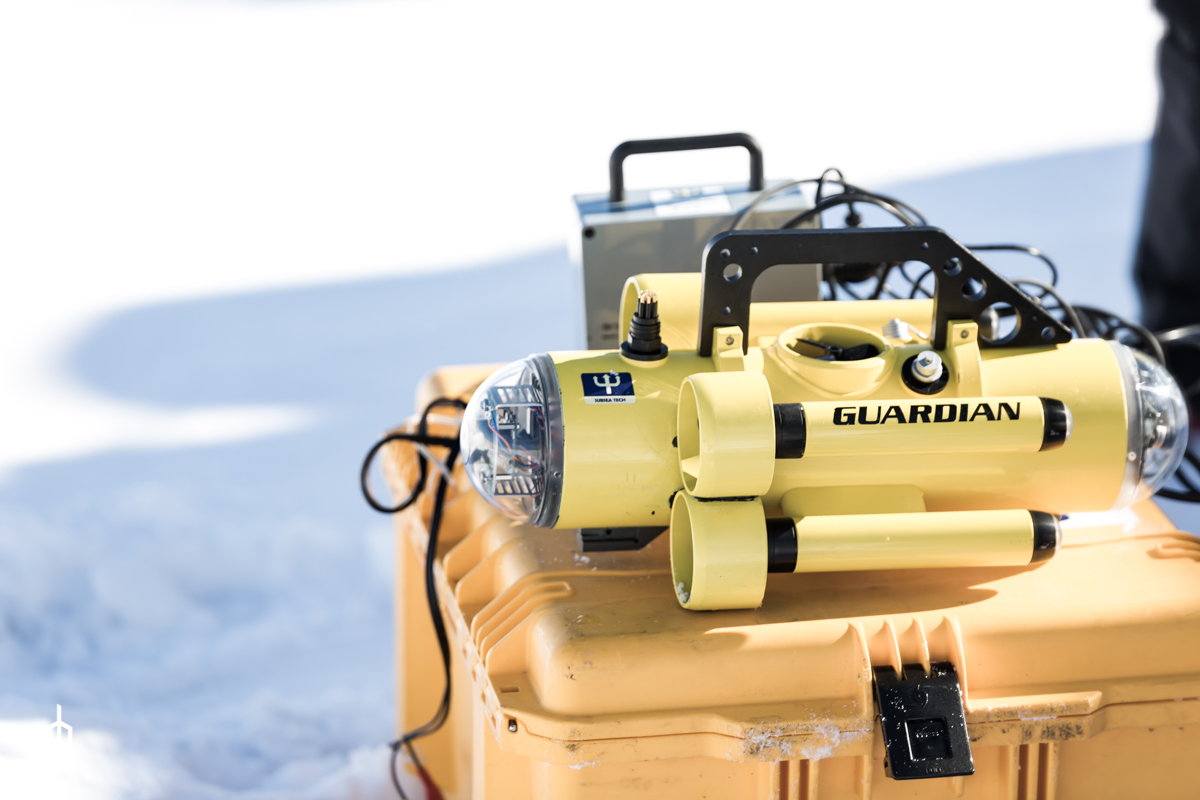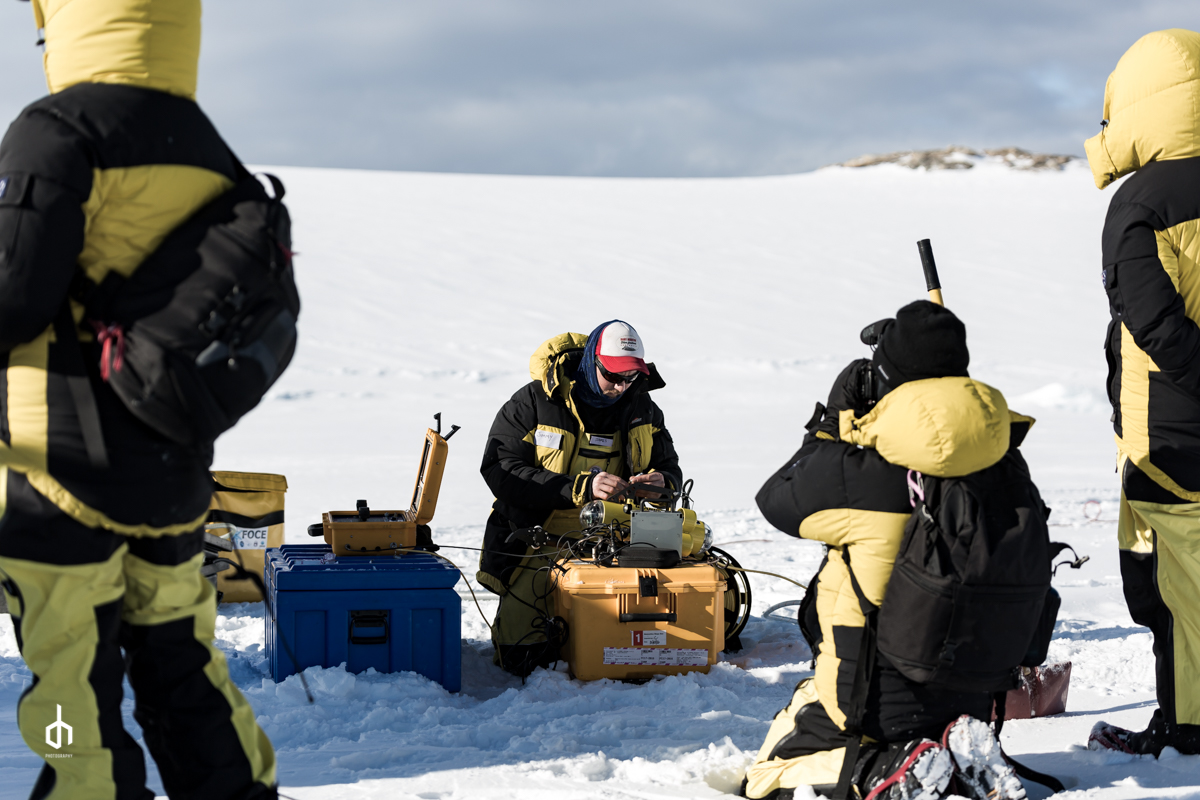A couple of weeks ago I was asked if I would like to join scientists James Black and Glen Johnstone for a trip on to the sea ice to help collect samples for their research on ocean acidification. This particular trip was somewhat special in that we also had two journalists from the Huffington Post tagging along to gather content for their upcoming stories! Not only would I be getting off station, but taking a ride in one of the Hagglunds on to the sea ice! Due to the nature of their research, James and Glen are the only people on station permitted to actually do this, as there have been incidents in the past where Hagglunds have fallen through the ice. Luckily they float! This was a great chance to get involved, see more of Antarctica and give the camera a good work out. Needless to say, I was pretty excited. A rare opportunity, especially for the station chef!
Green Hagg covered in ice.
I got up at 5am to get myself organised, make sure my survival pack was in order and sign out a big Down jacket as we would be stationary in the field for quite some time. Just before we left, we packed some lunch, filled our thermos’ with coffee and turned our tags on the muster board to say where we were going, for how long we would be gone and who was in the party. Communications also needed to be notified of the above information with scheduled radio checks every hour. With all of these boxes ticked we gassed up and in two bright coloured Hagglunds headed out of station and off towards O’Briens Bay where the day’s activities would take place. Driving in the Hagglunds is an experience in itself. Everyone inside wears a head set, much like that of a helicopter, as the noise from the engines is deafening. This allows internal communication as well as with other vehicles and the station. I couldn’t help thinking that this must be what driving a tank is like. The grinding rumble of the engines and tracks as we carved a path over a previous trail covered up by the severe, ever changing Antarctic weather. Haggs are fitted out with radar and GPS for driving in whiteout conditions and are amphibious vehicles designed as troop carriers for the Swedish Army. They can go anywhere and that is why we have them.
Glen gassing up before we left station.
It took us about forty-five minutes to reach O’Briens Bay after stopping a couple of times for the Huffington Post journalists to get some shots. We descended to the sea ice and halted before embarking to go through a briefing from Glen as to procedures whilst operating out there. The main thing to take from this briefing was to keep our eyes and ears pealed and if you saw the scientists running, run with them; that means the sea ice is breaking up! However, the ice was 2.8 metres thick here, far more than is needed to hold the weight of a Hagglund. In fact, Haggs can safely drive on ice that is 60cm thick so there isn’t much danger.
After the briefing, the journailsts parked Yellow Hagg on the edge of the sea ice to film whilst we took Green Hagg out to the sites that Glen and James had drilled on past expeditions. The holes were just covered in snow and after the gear was unpacked needed to be scooped off with a chinois from the kitchen, revealing a tunnel 2.8 metres deep to the dark crystal-clear water beneath. I was told that visibility is near to 100 metres under the ice. Lack of current and constant shelter from above means the ocean floor remains undisturbed all year round. This was why it had been chosen as the place to collect the samples that James needs.
O'Briens Bay. The holes can be seen on the ice marked the distinct mounds with poles in them. The drill to make them sitting on a platform off the ice.
James Black, PHD Candidate at IMAS (Institute or Marine and Antarctic Studies) and leading scientist on this project, is one of many scientists around the planet studying Ocean acidification, which is essentially how the ocean is reacting to the increased carbon dioxide in the atmosphere. Black aims to increase physiological understanding of the effects of ocean acidification on phytoplankton and macro-invertebrates. Carbon dissolves into seawater lowering the pH which makes the water more acidic and affects the ability of marine organisms to form shells and other hard structures. In simple terms, animals relying on calcium carbonate for their shells are becoming worse off than plants which are experiencing higher growth from increased photosynthesis, thus the eco system and food chains could change in the future. Also, the Southern Ocean absorbs 40% of the global uptake of CO2, as cold water can absorb faster than warm water, hence why this study takes place in Antarctica.
James Black preparing the ROV.
On this day, we were taking samples of Diatoms (single cell micro algae), from the seafloor to be analysed later in the labs. They will eventually be packed up and shipped to Hobart, where the Australian Antarctic Division’s headquarters are for further analysis and lengthy study. Gear unpacked, James started to organise the ROV (Remote Operated Vehicle), which is to be sent down through the hole to vacuum up samples from the sea floor. The Huffington Post guys are filming and interviewing and I am busy soaking in the surrounds, taking loads of photos and buzzing off the rarity of this experience.
Soon everything was set up and James, Glen and I got to work. The ROV was dropped down the hole with James driving it from a control panel - a black rubbish bag over his head so that he could see the screen projecting real time footage from under the ice. Glen and I man the hose and pump. After a while we see a brown-green colour start coming up through the clear hoses connected to the vacuum, letting us know that we have some samples. The samples are pumped in to a plastic box of sea water and ocean sediment which is kept in the dark so as not to be effected by the sunlight, then buried in snow for when it is time to head back. After about an hour of taking samples we were having a break and standing around chatting when Glen looked over my shoulder with a surprised look… a Weddell Seal had just popped its head up, seen us and shot back down. A few minutes later it reappeared busting out of one of the covered holes fifty metres away! It was a big female and Glen thought, judging by her plumpness, that she was probably pregnant. The seal made a show of rolling around in the snow and doing a few poses for us before a couple of big yawns and slumping into what looks like a blissful nap. I was reminded of a happily overweight person lazing at the beach after a few too many Coronas. She looked as though she was in heaven, and as we get back to our work we could still hear her heavy breaths. The afternoon stretched on with the wind dropping off and the temperature rising. We took off our jackets and were working in fleeces and thermals, carefully applying sunscreen as not to be burnt from the scolding reflection off the ice. Having everything they needed, the Huffington Post guys departed with their escort leaving James, Glen and I to continue on for another couple of hours of sample taking. Later, a second seal popped out of the hole to slide up next to her pal, which we took a few photos of on a coffee break before finally finishing up for the day around 5pm.
Weddell seal yawning.
By the end of the day I was shattered. We packed the equipment away and piled in to the Hagg, said good-bye to our blubbery friends and departed the bay. Somehow throughout the day we managed to polish off three boxes of Shapes biscuits, which I’m told is not unusual as they are practically the the standard field ration for these guys. A quick radio check to comms to let them know we were off the sea ice and it was on the bumpy trail back to station, just in time for dinner and a couple of beers.














